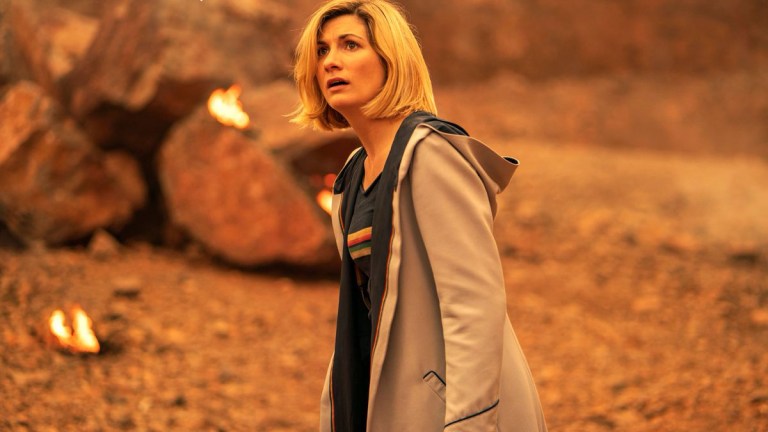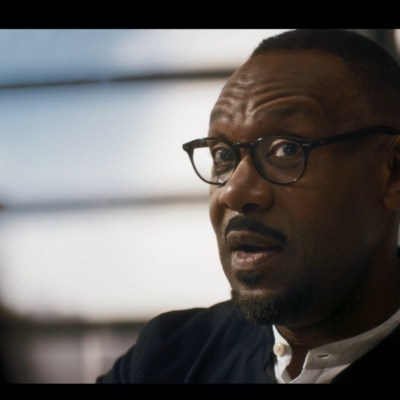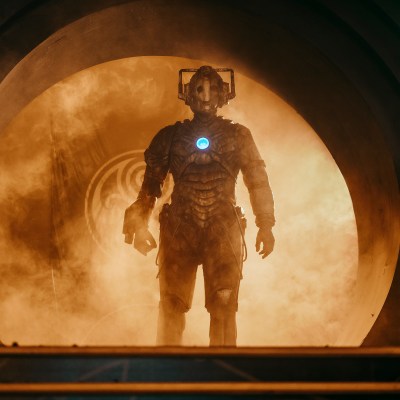Doctor Who Season 12 Episode 10 Review: The Timeless Children
It’s an unexpected homecoming in this week’s extra-long, extra-explosive Doctor Who. Spoilers abound ahead...

This Doctor Who review contains spoilers.
Doctor Who Season 12 Episode 10
“Everything you knew was a lie.” Bold words, all things considered. After a series of mostly standalone adventures in the Thirteenth Doctor’s first year, we’ve already spent much of season 12 watching Chris Chibnall and his creative team circling the show’s long history, tugging on threads that have always weaved decades of canon together… well, mostly.
That’s the thing about Doctor Who – it is, at its heart, a show about a quirky alien in a blue box who has adventures in time and space. The Doctor’s inspired Shakespeare, married into British Royalty, discovered the moon was an egg and watched the planet Earth be constructed to hide a Racnoss warship. For a program handed across generations of writers that has time-travel at its very heart, it’s amazing that the show hasn’t contradicted or flat-out rewritten itself more often.
That said, when you make the decision that your two-part finale is going to be all about disrupting that lore – when you’re banking that there are people who care about Gallifrey, and the Time Lords, and rules of regeneration dreamed up half a century ago – you are the one making the canon important. You’re agreeing that it matters, that it’s worth being invested in and having internet arguments about. Whatever changes you make not only have to respect what came before, the changes themselves also have to fuel an interesting story.
All of which is well and good, but it doesn’t answer the burning question: did “The Timeless Children” fundamentally change Doctor Who forever? That answer, without spoilers, is: nah, not really. You could even argue that other episodes in season 12 did most of the heavy lifting when it came to shaking up the continuity and tonight’s episode spends a lot of time reflecting on those events. There are a lot of callbacks, both in-universe but also to themes (and even lines of dialogue) from season-enders penned by Chibnall’s predecessors.
Let’s begin by discussing what story “The Timeless Children” presents in the here and now, because there really isn’t that much of it once you strip away the extended flashback scenes within the Gallifreyan Matrix, narrated at length by Sacha Dhawan – “Watch With Master,” if you will.
To get her to the Matrix in the first place, the Doctor is coerced through the Boundary and off back home to Gallifrey. This leaves the rest of Team TARDIS at the mercy of Ashad and his Cybermen; Graham and Yaz remain trapped aboard the cyber-carrier while Ryan and future-teen Ethan are left stranded back at Ko Sharmus’s camp.
Last week’s episode painted a pretty bleak picture for humanity, so it’s surprising just how many breezy moments there are this week. To begin with, Graham has the notion that the humans aboard the cyber-carrier can escape the danger… by dressing up as Cybermen. (Did anyone else have flashbacks to William Hartnell squatting inside a Dalek travel machine?)
It’s a ridiculous scheme, but the episode plays it with a straight face for the most part, ramping up the tension when Ashad himself comes close to discovering them. Most of what we see is Yaz and Graham hiding inside the emptied-out casings, thankfully, rather than stomping around going “YEZZZ WE ARE CYYYYBERMEN”, so it’s not as cartoonish as it could have been.
Down on the planet, Ryan overcomes his aversion to guns – a far cry from the teen who was happy to go all “Call of Duty” in “The Ghost Monument” – and helps Ethan and Ko Sharmus fend off squadrons of approaching Cybermen before the two groups of humans are eventually reunited.
Ashad, meanwhile, has been invited to Gallifrey by the Master, who’s already trapped the Doctor in a paralysis field. We get a very meta conversation between the two villains: Ashad reveals his intention to upgrade the Cybermen into fully mechanical creatures that will go on to rid the universe of all organic life, and the Master (quite rightly) calls this plan a load of utter bobbins. In last week’s review, I pointed out that the Cybermen seemed to be lacking a clear focus that made them engaging to watch in action, and this dialogue basically confirms it.
We never find out why Ashad was making that one Cyberman scream, either, and now we never will – because the Master immediately whirls and zaps him with the Tissue Compression Eliminator. This is a really effective moment; far more vicious than the gloating Masters of old, as Dhawan’s regeneration has proven himself to be.
It’s also a moment that exposes Chibnall’s tendency to undercook his villains when he knows the story is eventually going to shift focus away from them. It happened with Daniel Barton and the Kasavin in “Spyfall” once the Master showed up, and it happens to the Cybermen here. Once Ashad is dead, the rest of his troops spend the rest of the episode in a sort of holding pattern, all-but-vanishing from the plot while they wait for the good guys to come back and blow them up.
The Master soon joins forces – and forms – with the Cyberium, which is a bit odd considering that for much of “The Haunting of Villa Diodati” it really seemed as though the Cyberium didn’t want to be found by the baddies. It was presented instead as a relatively benign intelligence that was trying to protect itself from Ashad. This week, it readily hands the Master everything he needs to create his own army of cyber-creatures, using dead Time Lords so that the organic parts can repair and restore themselves. Once The Master’s sorted out his own unkillable army, it’s off to – what else – conquer the universe.
This entire run has played fast and loose with the ‘rules’ of the Cybermen – how they’re created, how and why they do what they do, and how much independent thought they have. Thematically, in a story that’s all about regeneration, it makes sense for the ultimate threat to be something like this. In practice, though, it raised far too many questions for me to take the idea seriously. How were these Time Lords ‘dead’ if their bodies could still regenerate? How does this make them immune to disintegration or other more deadly forms of attack? The Cyber-Lords look fantastic, but it was obvious they were never going to make it to the end credits.
While all of this is going on, the Doctor has been plugged into the Matrix and forced to confront the Great Big Lie of the Time Lords. The Time Lord ability to regenerate stems from a single, immortal alien known as the Timeless Child, and that child is the Doctor. Moreover, it seems that many of the Doctor’s earlier regenerations involved working for some form of Gallifreyan secret service before effectively undergoing a factory reset at the end of her tenure.
Let’s break this down because it’s really two revelations and they’re only loosely connected. The first half-hour of this episode is essentially Gallifrey 101, as the Master walks the Doctor (and anyone in the audience not steeped in Time Lord history) through some of the basics – the Citadel, the Panopticon, the Matrix. What we don’t hear is one important name: Rassilon, who we’ve always been told was the founder of the Time Lords and invented regeneration. Here, that honour goes to Tecteun, effectively the Doctor’s foster mother.
The Master vaguely alludes to the Time Lords making up a suitably grand origin story after the fact, but I’m forced to wonder – why not simply have had Rassilon find The Timeless Child? The twist here is not that someone invented regeneration, we’ve always known that, but that the Doctor herself is the blueprint for the process and has had many, many other lives as a result. That’s huge news for her, of course, but why keep the specifics of a “Timeless Child” aiding in the discovery of regeneration so secret? A single line of dialogue explaining how and why Rassilon replaced Tecteun in the history books would have been all that was needed, and the total omission of his character from this new canon is really quite baffling.
The second reveal is that at some point during her past, the Doctor joined up with a Time Lord agency known as ‘The Division’ that violated their world’s normal rules of non-interference. The “Brendan” cutaways we saw last week were actually a kind of filter placed over the information to disguise the Doctor’s service and eventual memory wipe, ensuring it wouldn’t be purged from the Matrix.
This is apparently news to the Doctor, but clues were laid out fairly explicitly in “Fugitive of the Judoon,” where Gat stated that she used to be Ruth’s commanding officer. Fans have had over a month to get used to the idea that Hartnell might not have been the ‘first’ Doctor, so this comes across as clarification rather than a huge mind-blowing shock. (Plus, as the Doctor points out, the new knowledge does nothing to change the person she is today.)
What’s weird here is that Gallifrey already has its Celestial Intervention Agency, a secret service designed to covertly interfere in other worlds’ affairs, and they don’t get so much as name-checked here. So much of what we learn in this episode comes from ignoring established continuity only to replace it with things that are basically the same – The Division instead of the CIA, Tecteun instead of Rassilon. These feel like changes for change’s sake, rather than being necessary alterations to canon so that the story of the Timeless Child could make sense.
With the truth laid bare, there’s a final showdown where the Doctor prepares to sacrifice herself to stop the Master and his army by making use of a “death particle” inside Ashad’s shrunken corpse. She’s saved from certain death when Ko Sharmus returns and takes the death particle from the Doctor, ensuring that she’s able to escape. Unfortunately, the drama of his death is slightly undercut by the sight of a TARDIS materialising disguised as a small new build property, which made me laugh much more than is probably healthy.
The Doctor, and by extension the audience, was promised that everything we knew was about to change forever. Instead, much of “The Timeless Children” felt familiar: the Master building a Cyber-army out of corpses, his “For Gallifrey!” speech directly paralleling Rassilon’s in “The End of Time,” and so on. And yet, there were plenty of little triumphs too. Ashad’s death, Ryan’s basketball skills paying off as he fought the Cybermen and that triumphant moment where the theme music kicked in (has it ever been used as part of the soundtrack before?) and the Doctor broke free of the Matrix with the power of her own forgotten memories.
Could this episode have ever lived up to its own hype? Probably not, but it’s quite remarkable how little has actually changed now that it’s over and Gallifrey’s still gone. Having spent weeks wondering if Chris Chibnall’s desire to reinvent Doctor Who would cause him to go too far, it’s hard not to feel that he ended up not going far enough – particularly when it came to the Cyberman story that was unfolding in the here and now. Had “Fugitive of the Judoon” never existed and the Ruth-Doctor had made her debut during this two-parter, we’d all have been left reeling from the surprise. Instead, we’re left nodding thoughtfully at a belated explanation.
Still, at least the Morbius Doctors are canon now, eh?
Doctor Who will return in Christmas 2020/New Year 2021 special “Revolution of the Daleks”.


